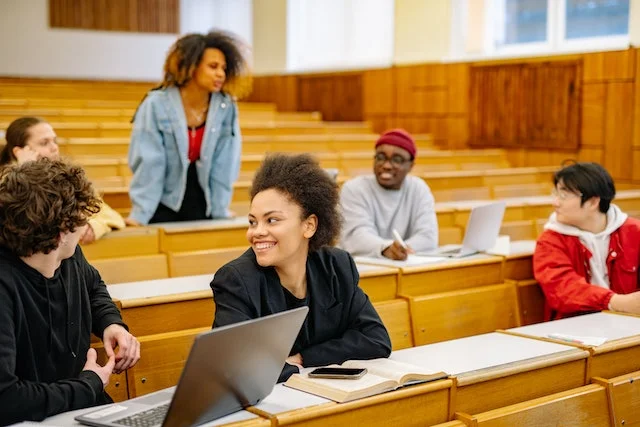Face-to-face communication might seem old-fashioned, but it packs a punch! We understand each other better with just a look and a gesture, building stronger bonds along the way. Brainstorming? Ideas fly faster when we’re in the same room, leading to smarter decisions and getting things done quicker. Of course, it’s not perfect. Not everyone’s always around, and sometimes things can get heated. But when it comes to building trust, working together, and truly understanding each other, face-to-face wins every time. Remember, it’s a tool, not a rule – choose the right one for the job!
Face-to-Face Communication: Quick Comparison
| Features | Advantages | Disadvantages |
|---|---|---|
| Clarity | Nonverbal cues, immediate feedback | Misinterpretation, limited visuals |
| Relationships | Trust, empathy, connection | Bias, intimidation |
| Collaboration | Real-time ideas, shared context | Limited reach, logistics |
| Decision-Making | Emotional context, informed choices | Groupthink, dominant personalities |
| Productivity | Emotional context-informed choices | Time, cost, accessibility |
| Accessibility | Limited reach, physical barriers | Inclusion, participation |
| Conflict Management | De-escalation, context cues | Risk of escalation |
Advantages of Face to Face Communication
- Enhanced Emotional Connection: Studies reveal that face-to-face interactions activate mirror neurons, fostering empathy and building stronger emotional connections. This, in turn, enhances trust within relationships.
- Nonverbal Cues: Over 55% of communication is conveyed through nonverbal cues such as facial expressions, body language, and tone of voice. These subtle nuances play a vital role in facilitating clearer communication and reducing misunderstandings.
- Active Listening: The physical presence and eye contact associated with face-to-face interactions encourage active listening, resulting in better understanding and engagement. This active engagement contributes to more fruitful conversations and effective problem-solving.
- Building Rapport: Shared physical space and experiences during face-to-face interactions create a foundation for building rapport and stronger bonds. This is particularly beneficial in fostering trust and collaboration.
- Spontaneous Interaction: this type of communication allows for spontaneous interactions, supporting real-time idea sharing, immediate feedback, and non-verbal cues that enhance collaboration.
- Immediate Clarification: Immediate interpretation of nonverbal cues enables instant clarification of messages, reducing the potential for misunderstandings and misinterpretations.
- Holistic Decision-Making: Face-to-face discussions enable a better understanding of others’ emotions and intentions, contributing to more informed and holistic decision-making processes.
- Efficient Problem Resolution: Studies show that face-to-face meetings can be 34% more efficient than virtual meetings, leading to faster resolution of tasks and improved overall productivity.
Disadvantages of Face to Face Communication
- Miscommunication: Despite the presence of nonverbal cues, misunderstandings can arise due to individual biases, cultural differences, or varying interpretations. Addressing these disparities is essential to prevent frustration and conflict.
- First Impression Bias: Initial impressions formed in face-to-face encounters can be challenging to overcome, potentially impacting individuals who struggle with introductory interactions.
- Social Pressure: Certain individuals experience anxiety or discomfort in face-to-face settings, particularly in larger gatherings. This discomfort can impede effective communication and hinder full participation.
- Logistical Challenges: The process of scheduling face-to-face meetings can be time-consuming and inconvenient, especially for geographically dispersed teams or individuals with busy schedules.
- Limited Reach: Face-to-face communication is confined to individuals who are physically present, posing challenges for remote or geographically dispersed interactions.
- Time-Consuming: Compared to quicker communication methods like email or texting, face-to-face interactions can be time-consuming, potentially affecting efficiency.
- Lack of Documentation: The absence of documentation in face-to-face communication makes it challenging to revisit specific points or decisions made during the interaction, as there is no recorded history.
- Potential for Distractions: Distractions, such as background noise or interruptions, can interfere with the effectiveness of face-to-face communication, diverting attention from the intended message.
- Dependence on Nonverbal Cues: Face-to-face communication heavily relies on nonverbal indicators like body language and facial expressions, which may be subject to misinterpretation or misunderstanding.
Statistical Insights
- 70% of communication errors stem from misunderstandings, highlighting the need for careful interpretation of nonverbal cues.
- Active listening increases information retention by up to 50%, showcasing the effectiveness of engagement in face-to-face interactions.
- Face-to-face interactions lead to 34% higher levels of trust compared to virtual communication, emphasizing its impact on relationship-building.
- Social anxiety affects over 13% of the global population, potentially influencing face-to-face communication.
Conclusion
Although this live communication is a powerful tool for building connections and understanding, it’s crucial to navigate its strengths and weaknesses carefully. Ultimately, the best communication mode depends on the situation and the participants involved. By understanding the advantages and disadvantages of communication, we can choose the most effective approach for each one.

